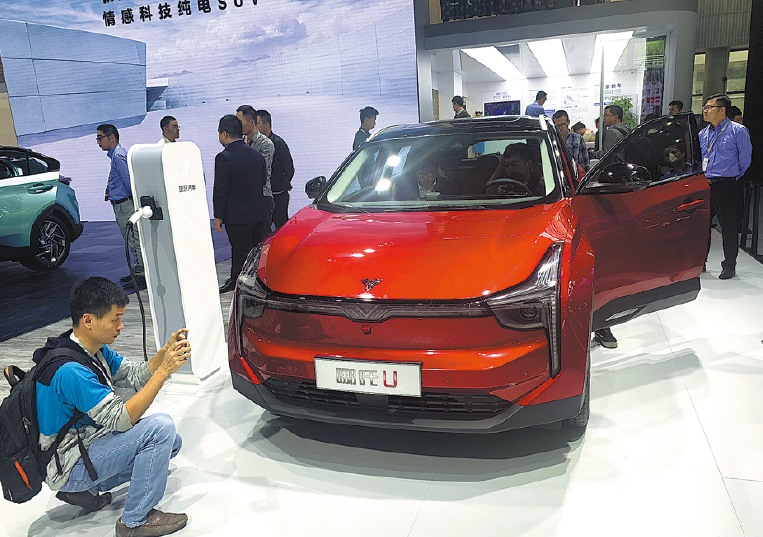Cut-price electric vehicles aim to spark countryside revitalization

A Nezha U electric model catches visitors' eyes at the Guangzhou auto show last year. [Photo by Cao Yingying/China Daily]
The Chinese government has enacted preferential measures on new energy vehicles in rural areas that will last until December, in an effort to boost sales and the rural revitalization strategy.
According to a notice the Ministry of Industry and Information Technology released on Wednesday, a total of 10 domestic carmakers, including Great Wall, Changan, Chery, BYD and BJEV, are to promote 16 new energy vehicle models throughout the countryside.
The automakers are offering varying discounts, on average 2,000-5,000 yuan ($285-$715), according to the China Association of Automobile Manufacturers who will be carrying out related events in rural areas from late July.
The local governments will provide subsidies to encourage villagers and reduce the expense for them to trade for with new energy vehicles.
Five promotional events are being organized for rural residents in Qingdao in Shandong province; Haikou in Hainan province; Kunming in Yunnan province; Chengdu in Sichuan province; and Taiyuan in Shanxi province.
From July 2019, China's new energy vehicle sales retreated for 12 consecutive months after a steep cut in government subsidies.
In the first half of 2020, the sales of new energy vehicles reached 393,000 units, a decline of 37.4 percent year-on-year.

BJEV showcases its electric model at the Shanghai auto show in 2019. [Photo by Li Fusheng/China Daily]
But the CAAM data shows the sector has registered a monthly recovery. In June, a total of 104,000 new energy vehicles were sold, up 26.8 percent from May.
Chen Qingtai, president of China EV100, the industry's leading think tank, said at the Automotive Market and Consumption Forum on Saturday that China's vehicle sales growth will expand and move from the east to the central and western regions, from cities to villages. He estimated that by 2030, 160 people per 1,000 will own a car in rural areas, adding up to more than 70 million vehicles.
Xu Haidong, vice-chief engineer of the CAAM, said that new energy vehicles have a huge market in China's vast rural areas and hold many advantages over gasoline vehicles.
The advantages include the convenience of installing charging piles as most families in rural areas have yards outside their homes, they are cheaper to "fuel" than gasoline cars and have lower maintenance costs because new energy vehicles have fewer components.
According to research by CAAM, the car purchase budget of rural customers is less than 50,000 yuan on average.
The promoted models will be priced below 100,000 yuan and carmakers are expected to subsidize and cut prices for villagers.
For example, BJEV will cut the price of its EC3 model from 73,800 yuan to 59,800 yuan and will provide a subsidy of 5,000 yuan if a customer trades in his or her vehicle.
Changan is to sell its E-Star in rural areas. The carmaker said it will introduce a comprehensive car purchase policy of 10,000 yuan, which includes exchange subsidies, a free charging pile and cash discount, according to Shanghai Securities News.
Zhejiang Hozon New Energy Automobile Company is one of the carmakers that will launch promotional events in rural areas.
The founder and chairman of the company, Fang Yunzhou, said promoting new energy vehicles in rural areas will help more Chinese to enjoy better transportation, promote the upgrading of supporting industrial chains and provide more jobs for local people.
Yale Zhang, managing director of Shanghai-based consultancy firm Automotive Foresight, said after the government subsidies' cuts, compact electric vehicles were losing market share because they have no advantage over rival gasoline vehicles.
"The promotional events in rural areas will help to promote the sales of small new energy vehicles, as well as replace the low-speed electric vehicles which are widely used in rural areas and are not safe and don't meet any production standards," Zhang said.
According to the market research firm Zhiyan Consulting, there will be 5 million low-speed electric vehicles in rural areas by the end of 2020.
Zhang said that their low price is the most competitive factor in rural areas. Carmakers should launch low-price new energy vehicles, even they don't feature long ranges or large capacity batteries, he suggested.
Editor: John Li